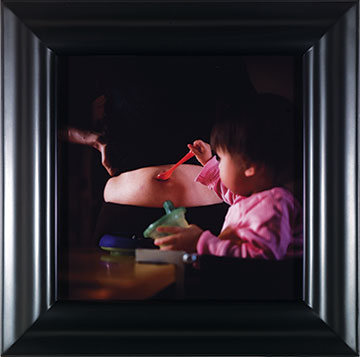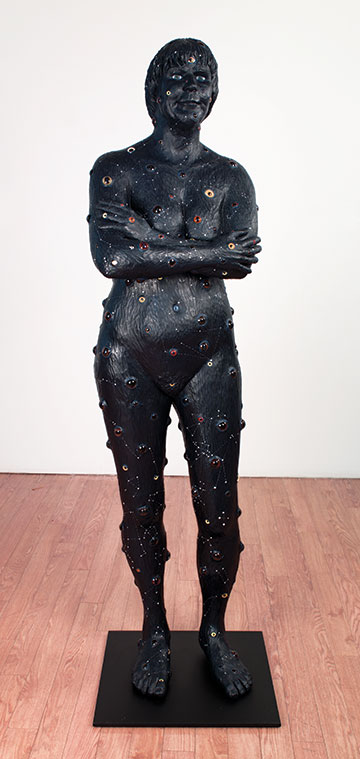One Another: Spiderlike, I Spin Mirrors: Selections from Women Artists of the Albright-Knox Art Gallery Collection
by Patricia Pendleton




Body of Evidence
There is a web of evidence in this meditation on women, beauty, decay, and the restorative qualities of art. Relationship is explored in an extensive display of objects from the Albright-Knox collection. One Another: Spiderlike, I Spin Mirrors is titled after the work of Janine Antoni and the late Louise Bourgeois, along with a poem by Sylvia Plath.
Bourgeois is often regarded as an art mother by those who found a role model in her confessional style, which gained notoriety during the 1970s. She describes her art process as a series of portraits of a relationship and adopted the spider as a central theme in her later work. Representative of the female protagonist, the image was also an ode to the strength of her own mother and the relationship they shared. This show highlights the work of Antoni and Bourgeois in relation to examples from some of the most influential female artists of our time as they grapple with interdependence, social roles, and identity.
The speaker of Plath’s poem, “Childless Woman,” describes the way infertility has rendered her body aimless, like a dried-out plant or a knot turned back on itself instead of leading to a future. She “spins mirrors,” which capture nothing but her own reflection and the image of death, the only culmination of which her body seems capable.
Neither Plath nor Bourgeois were childless, and Antoni is a mother today. While we have moved beyond the limiting notions of Plath’s 1950s-era womanhood, issues around reproduction and the body remain central to the lives of women. The artworks here employ the figure (body) as a vehicle for the exploration of empowerment, memory, self-preservation, sexuality, and transformation. The body as a metaphor for the passions and trials of human existence is a frequent theme in the work of female artists during the last fifty years. Shared influence is woven throughout the exhibition.
Antoni offers herself as a “performative object” in the theatrical staging of her works. The small color print titled Momme appears to be a profile of an ordinary woman in a long dress sitting placidly on a sofa—until you notice the curious lump under her garment and an extra pair of bare feet (spiderlike) on the floor below. Her large-scale color print, Inhabit, features a nude woman encased in an elaborate harness within a dollhouse and strung up in a web above a fire truck rug, stretched across a child’s bedroom between the bunk beds and red wagon. Notice the menacing black spider crawling up her thigh.
On the adjoining wall hangs a Laurie Simmons’s gelatin silver print from her Walking and Lying Objects series. During the 1980s, the artist began exhibiting her exploration of dollhouse miniatures, toys, and domestic items that conjure a sense of place and familiarity. Magnus Opus II (the Bye-Bye) is a scene of interplay between a toilet, pocketwatch, house, camera, globe, and microscope—all related by the female legs they walk upon. Also known as the mother of celebrity Lena Dunham, Simmons has her own film that is available to view online, The Music of Regret, a musical that brings to life her curious walking objects.
Kiki Smith investigates the body as a storytelling vessel. A lithograph from 1990 is a mass of strands from a Cher wig and imprints of her face. I learned that Smith has a special connection with hair, as she was named after Saint Clare of Assisi, the Catholic saint who cut her long strands as a ritual act after refusing marriage in order to devote herself to the care of the poor.
(Hair, the feminine symbol for seductive beauty, turns up in Antoni’s earlier work—see an in-depth visit with her in the second season of the television series, Art 21. This includes a clip of her hair-painting performance, Loving Care, as she crawls about swinging her dye-soaked locks onto a canvas on the floor. The tradition of hair as a subject in contemporary art continues locally in the paintings and drawings of Buffalo artist, Amanda Besl, recently on view in area galleries.)
Smith’s Bronze, edition 2/3 is a nude female on the ground after being ripped (born) from the body of small fawn. The piece seems to be echoed by Alison Saar’s fetal-posed female in Bareroot, whose feet grow into branches.
Other works consider women as mothers of nature and the transformation of feral human quality into the civil self. A series of etchings by Bourgeois depict one-legged, headless, uniformed figures with tree branches as stand-in legs and crutches. Antoni’s 2038 tenderly depicts a cow that appears to be nursing from a woman who is bathing in the water of the trough. Antoni uses herself again as a model for the molded rawhide form that suggests a woman crawling animal-like on the ground in a submissive pose.
Erika Wanemacher creates resonant objects. Her wood and steel sculptural self-portrait is covered with glass taxidermy animal eyes. Of the Beasts represents pagan ritual nudity called Skyclad. Take time to consider the well-chosen words that honor the relationships and connections so important to any published writer’s work in the pyramid collage of book dedication pages by Valeska Soares.
This show opened during Women’s History Month, a national celebration since 1987. The gallery rooms are full of history and richness in work that spans decades, including significant works by early feminist artists Ana Mendieta, Hannah Wilke, Lynda Benglis, and Eva Hesse. The accompanying text adds unifying context to the seemingly distinct visual expressions that point to essential human connection. Bourgeois turned away from her assigned role as the art mother when she commented: “I am not interested in being a mother. I am still a girl trying to understand myself.” Isn’t that what all art aims for—new understanding?
On view through May 3, there is plenty of new understanding to take away from One Another.
blog comments powered by Disqus
|
Issue Navigation> Issue Index > v13n14 (Week of Thursday, April 3) > Art Scene > One Another: Spiderlike, I Spin Mirrors: Selections from Women Artists of the Albright-Knox Art Gallery Collection This Week's Issue • Artvoice Daily • Artvoice TV • Events Calendar • Classifieds |









 Current Issue
Current Issue